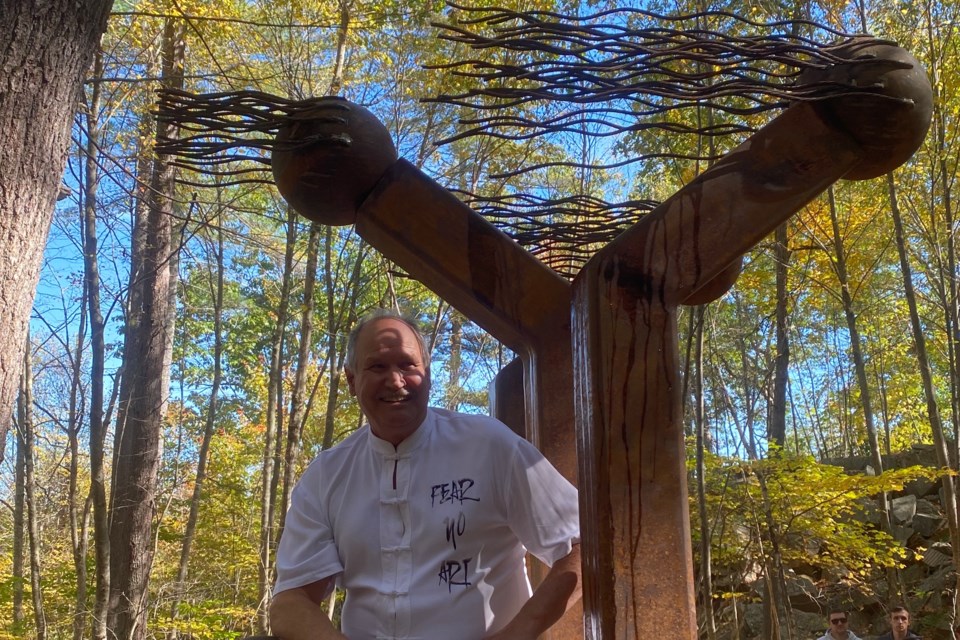MOUNTAIN VIEW COUNTY – A globe-trotting Bergen-area sculptor who is no stranger to the international stage was the only Canadian who attended a symposium in the U.S.
Morton Burke, whose property southwest of Sundre is the site of a sculpture park featuring a variety of works accumulated over many years, got home earlier this week from the 24th edition of Bridges and Connections International Sculpture Symposium in Brookline New Hampshire.
The three-week event took place from Sept. 14 to Oct. 6 at Andres Institute of Art, where Burke was among three artists who were chosen by a selection committee that determines qualified participants based on their previous experience. Influencing the committee’s decision to pick Burke were his efforts to raise awareness about, as well as grow a greater appreciation for, the cultural contributions of art through similar symposiums he has previously organized and hosted on his acreage – the home of Bergen Rocks International Sculpture Park – that were similar to the programs presented by the Andres Institute of Art.
The other two artists at the event in New Hampshire were from New Mexico and Maine, and they were all instructed to arrive with a blank pallet – no preconceived notion of what they might intend to create, Burke said in a press release.
The first two days were dedicated to granting the sculptors an opportunity to conjure up a design and consider what kind of medium and tools they planned to use, he said, adding they were also “encouraged to step out of their comfort zone and create in a style, scale or medium that they haven’t worked in previously.”
With extensive experience working with hard-packed snow, stone and wood, this provided Burke with a unique opportunity to expand upon his artistic repertoire and he decided to broaden his horizons by endeavouring to work with metal, a medium he’d never before worked with.
A brief introductory lesson into the basics of welding provided by John Weidman, a cofounder and artistic director of Andres, got Burke going in the right direction.
During their time at the symposium, participating artists are placed with local families, and on the first night following his arrival, Burke said he learned during the initial visit with his hosts that Mt. Washington once held the world record for wind speeds after recording in 1934 a speed of almost 372 kilometres per hour (231 miles per hour).
According to the Mount Washington Observatory’s website, that record stood for more than 60 years. But while a higher wind speed was later recorded in 1996 during Tropical Cyclone Olivia at Barrow Island, Australia, the Observatory’s measurement “still stands as the fastest wind speed ever recorded by a staffed weather station.”
This new knowledge immediately planted the seeds of inspiration in Burke’s mind and as he went to bed that night, he began to wonder whether he might create a piece that would depict the wind’s strength. As a design made from stone did not seem practical, that solidified his decision to try working with steel.
The resulting sculpture’s main body was made using hollow structural steel sections with approximately 18-centimetre by 18-centimetre (7-inch by 7-inch) dimensions as well as roughly 30-centimetre (12-inch) steel balls for the heads and 90-year-old cable that was left behind at a nearby quarry site when it closed.
The piece – which Burke went on to call “Into the Wind” – consists of two figures leaning into the wind and one leaning back as if almost being blown over and took more than 100 hours to make.
“The hair of all three is being blown back violently, all in the same direction,” he said, adding visitors who attended the unveiling instantly picked up on the reference to wind.
While the winds on Mt. Washington served to inspire the sculpture, the piece ultimately references wind all over the world and will be relatable for anyone who sees it, he said.
“Everyone has experienced wind regardless of where they are from,” he said, adding that’s why the piece can be a successful sculpture.
Although learning to weld was a challenge that occasionally bordered on frustrating, Burke told the Albertan that’s all a part of the learning process involved in artistic pursuits and that the experience overall was rewarding in the sense he’s broadened his artistic toolkit.
“I enjoyed overcoming the difficulties and realizing I could do it,” he said on Oct. 10 during an interview, adding he now fully intends to further explore the medium after overcoming the initial fear of welding.
“I’ve got a great big pile of metal out here,” he said, referring to his property.
“It’s a neat medium because it lends itself to other forms that you couldn’t achieve in snow or ice or stone or wood or the other things that I’m comfortable working with.”
Visit bergenrocks.com for more about Burke and his sculpture park located southwest of Sundre near Bergen.
- RELATED: Sculptor has spills, chills at International Ice and Snow Festival in China
- RELATED: Sundre-area sculptor leads Alberta team’s return to China to share message of peace
- RELATED: Sundre-area sculptor competes with team at world championship event in Minnesota
- RELATED: Bergen man sculpts out success at Chinese ice and snow festival



